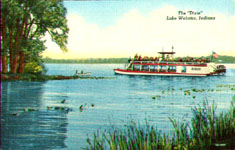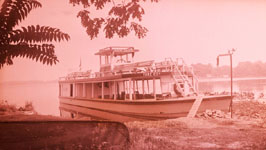
By 1928 the first Dixie's wooden hull was in very poor condition. Breeck decided to build a new, steel hulled boat. In late 1928 he ordered a steel hull from the Barbour Metal Boat Works Company of St. Louis, Missouri.

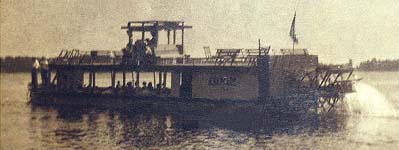
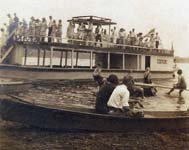

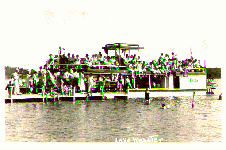
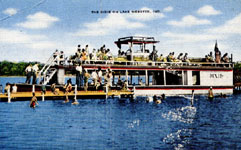
In early 1929 the galvanized steel hull was shipped by rail, in four sections, to the Leesburg, Indiana train station. According to Doc Hamman, the hull sections were transported by truck to the city street in North Webster. Doc Hamman, Bud Mock and Herbert Kuhn assembled the hull at this location using hot rivets. The assembly was performed atop a specially made boat slip. The slip was made of two oak trees which had been cut, milled square, and coated with grease.
When the hull was first launched, a leak was found where two rivets had been left out. In order to fix the leak the hull had to be winched out using a make-shift turnstyle and horses.
Other hardships would be encountered during construction. For instance, the Dixie's paddlewheel and flywheel are both mounted on solid steel axles, or jackshafts. The flywheel, gears, and paddlewheel hubs all require "keys" to hold them in place on the shafts. The keyways had to be milled out by hand, as powertools were very rare in 1929. The milling of each keyway involved the hand drilling of several holes into the solid steel shaft. Then a carbide chisel was used to hand-carve the keyways into square slots.
The New DixieThe new boat retained the Dixie name. In fact, for many years it was known as the New Dixie. The design of the new Dixie strongly resembled that of the first Dixie. The main difference being the first Dixie had the traditional "swayback" look of a steamboat. Large wooden-hulled vessels used the swayback design to give them strength. The new Dixie's steel hull was stronger and did not require the swayback design.
The PilothouseLike the first Dixie, the new Dixie's pilothouse was located near the middle of the top deck. This meant the pilothouse was closer to the engine room, allowing the pilot to control the engine directly. The pilothouse contained various pull-chains and levers which controlled the Fordson tractor powerplant. A foot lever controlled the clutch, while a rope/pulley mechanism selected the desired gear.
The design of the pilothouse was identical to that of the first Dixie's. The crew entered the pilothouse through a door at the rear of the pilothouse, on the starboard side. The ship's wheel had been salvaged from the first Dixie. An early directional spotlight hung from the roof of the pilothouse. The spotlight had a parabolic mirror which swiveled about the lamp assembly, allowing it to be aimed.
The WhistleThe Dixie's whistle was used aboard the first Dixie from around 1918 to 1928. It was salvaged and installed on the new Dixie in 1929. From 1929 to 1949 the whistle was located on the port side of the top deck, at the stern. A pull-chain in the pilothouse controlled the whistle.
The whistle is a Gabriel 3-chime exhaust whistle. Exhaust whistles were common on early automobiles before the use of electric horns. The whistle was connected to an air compressor in the engine room. It was powered by a belt and pulley on the end of the flywheel/jackshaft. This meant the air compressor ran whenever the Dixie's paddlewheel ran. Since the paddlewheel runs for extended periods, the compressor's reservior tank required a relief valve to prevent it from being over-pressurized.
The PowertrainAccording to Jim Hamman, when the Dixie was launched in 1929, it briefly used the steam engine that was used by the first Dixie in its early years. Steam engines required much care and maintenance. By 1929 it was much easier to use gasoline engines for these applications. It is possible that Breeck used the old steam engine for sentimental reasons. The steam engine was immediately replaced with the Fordson tractor that had powered the first Dixie in its later years.
The Fordson tractor was mounted in the engine room. A 10-inch wide belt connected the tractor's hub to the Dixie's flywheel/jackshaft. The Fordson tractor had been in use aboard the first Dixie since the early 1920's, and by 1934 it needed to be replaced.
The 1933 World's Fair in Chicago had produced a large amount of traffic on Lincoln Highway (today's U.S. 30). Broken-down and abandoned vehicles were very common along the highway. These vehicles could be purchased very cheaply at auctions. Breeck purchased one of these vehicles to replace the aging Fordson tractor, and in 1935, a 1928 Studebaker became the Dixie's new powertrain.
Gaskill and Breeck flipped a coin to see who would take the Dixie for its last trip with the old Fordson powerplant. Harold won the coin toss and took the Dixie on the short trip to the Willis Park channel. A mechanic who lived along the channel replaced the Fordson tractor with the 1928 Studebaker chassis.

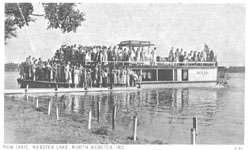
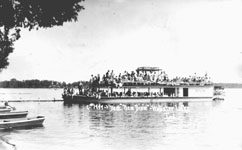
In the mid-1920's Breeck had acquired a large parcel of lake property at the edge of town. This became the main docking location for his boats, and was later known as Dixie Camp.
The Knapp-Pierson EraJoe Breek had built and operated sternwheelers on Webster Lake since 1906. By 1939 he was forced to retire due to failing health. He sold the Dixie and lake property to Jay Knapp in 1939.
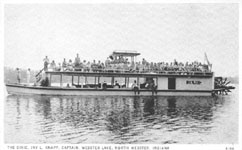
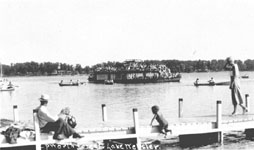
Jay Knapp was the captain of the Dixie, but he also had a business partner named Pierson. Very little is known about Mr. Pierson, except for promotional posters that state "Dixie Camp - Operated by Knapp & Pierson". They made several improvements to the cottages and camping area on the lake property, which then became known as Dixie Camp.
Knapp operated the Dixie for 10 years. The Dixie was well maintained during this period, and no significant changes were made to it.
The Ungeright EraEarl Ungeright purchased Dixie Camp in 1949. He made some significant improvements to the Dixie during his ownership. In 1949, he upgraded the Dixie's powertrain to diesel-electric. Several powertrains had been used in the past, with various levels of success. The diesel-electric powertrain would prove to be the best, and it is still in use today. A diesel engine runs a generator which provides 110 and 220 volt power for the boat. A variable-speed 15hp electric motor, designed to power elevators, is specially geared to drive the paddlewheel.

